Effects of Moisture on NH3 Capture Using Activated Carbon and Acidic Porous Polymer Modified by Impregnation with H3PO4: Sorbent Material Characterized by Synchrotron XRPD and FT-IR
Abstract
1. Introduction
2. Experimental
2.1. Sample Preparation
2.2. Breakthrough Curve Tests
2.3. Synchrotron XRPD
2.4. FT-IR Spectroscopy
2.5. TGA Analysis
3. Results and Discussion
3.1. Performance of H3PO4/C and H3PO4/A Characterized by Accelerated Aging Tests
3.2. Structure of H3PO4/C and H3PO4/A Characterized by X-ray Diffraction (XRPD)
3.3. Mechanism of NH3 Removal Using PC and PA
4. Conclusions
Author Contributions
Funding
Institutional Review Board Statement
Informed Consent Statement
Data Availability Statement
Acknowledgments
Conflicts of Interest
References
- Phillips, J. Control and Pollution Prevention Options for Ammonia Emissions; EPA-456/R-95-002; VIGYAN, Inc.: Vienna, Austria, 1995. [Google Scholar]
- Goçalves, M.; Sánchez-García, L.; de Oliveira Jardim, E.; Silvestre-Albero, J.; Rodríguez-Reinoso, F. Ammonia Removal Using Activated Carbons: Effect of the Surface Chemistry in Dry and Moist Conditions. Environ. Sci. Technol. 2011, 45, 10605–10610. [Google Scholar] [CrossRef]
- Koerkamp, P.W.G.G.; Metz, J.H.M.; Uenk, G.H.; Phillips, V.R.; Holden, M.R.; Sneath, R.W.; Short, J.L.; White, R.P.; Hartung, J.; Seedorf, J.; et al. Concentrations and Emissions of Ammonia in Livestock Buildings in Northern Europe. J. Agric. Eng. Res. 1998, 70, 79–95. [Google Scholar] [CrossRef]
- Brinka, C.; Kroezeb, C.; Klimont, Z. Ammonia abatement and its impact on emissions of nitrous oxide and methane-Part 2: Application for Europe. Atmos. Environ. 2001, 35, 6313–6325. [Google Scholar] [CrossRef]
- Behera, S.N.; Sharma, M.; Aneja, V.P.; Balasubramanian, R. Ammonia in the atmosphere: A review on emission sources, atmospheric chemistry and deposition on terrestrial bodies. Environ. Sci. Pollut. Res. 2013, 20, 8092–8131. [Google Scholar] [CrossRef]
- Chang, Y.H. Non-agricultural ammonia emissions in urban China. Atmos. Chem. Phys. Discuss. 2014, 14, 8495–8531. [Google Scholar]
- Melse, R.W.; Ogink, N.W.M. Air scrubbing techniques for ammonia and odor reduction at livestock operations: Review of on-farm research in the Netherlands. Am. Soc. Agric. Eng. 2005, 48, 2303–2313. [Google Scholar] [CrossRef]
- Oyarzun, P.; Alarcón, L.; Calabriano, G.; Bejarano, J.; Nuñez, D.; Ruiz-Tagle, N.; Urrutia, H. Trickling filter technology for biotreatment of nitrogenous compounds emitted in exhaust gases from fishmeal plants. J. Environ. Manag. 2019, 232, 165–170. [Google Scholar] [CrossRef] [PubMed]
- Cavaseno, V. Industrial Air Pollution Engineering; McGraw-Hill Publication, Co.: New York, NY, USA, 1980; pp. 287–291. [Google Scholar]
- Chou, L.-H.; Tsai, R.-I.; Chang, J.-R.; Lee, M.-T. Regenerable adsorbent for removing ammonia evolved from anaerobic reaction of animal urine. J. Environ. Sci. 2006, 18, 1176–1181. [Google Scholar] [CrossRef]
- Miysoshi, T.; Boki, K.; Tanada, S. Studies on the Adsorption Removal of Ammonia Gas. Jap. J. Ind. Health 1977, 19, 87–91. [Google Scholar]
- Yeh, C.-Y.; Chen, Y.-T.; Chen, N.-Y.; Chang, J.-R. Air Regeneration of Ethanol-Laden Pellet NaY-SiO2 and Pt/NaY-SiO2: Effects of Air Flow Rate on Pt Morphology and Regeneration Efficiency. Catalysts 2018, 8, 288. [Google Scholar] [CrossRef]
- Lee, M.-T.; Wang, Z.-Q.; Chang, J.-R. Activated-carbon-supported NaOH for removal of HCl from reformer process streams. Ind. Eng. Chem. Res. 2003, 42, 6166–6170. [Google Scholar] [CrossRef]
- Asao, O.; Wang, G.I. Deodorization performance of charcoal particles loaded with orthophosphoric acid against ammonia and trimethylamine. Carbon 2002, 40, 1391–1399. [Google Scholar]
- Kim, K.H.; Shin, C.S. Adsorption of Ammonia on the Sulfuric Acid Treated ACF. Carbon Sci. 2001, 2, 109–112. [Google Scholar]
- Guo, J.; Xu, W.S.; Chena, Y.L.; Lua, A.C. Adsorption of NH3 onto activated carbon prepared from palm shells impregnated with H2SO4. J. Colloid Interface Sci. 2005, 281, 285–290. [Google Scholar] [CrossRef] [PubMed]
- Wang, Y.; Jung, J.; Wen, J.; Ren, X.; Sun, Y. Removal of ammonia from atmosphere by air stripping with mesoporous silica-supported N-halamines. J. Environ. Chem. Eng. 2021, 9, 104900. [Google Scholar] [CrossRef]
- Mochida, I.; Kawano, S. Capture of Ammonia by Active Carbon Fibers Further Activated with Sulfuric Acid. Ind. Eng. Chem. Res. 1991, 30, 2322–2327. [Google Scholar] [CrossRef]
- Lu, Z.; Hines, J.A.; Rozewicz, D.J.; Hines, M.L. Ammonia Removal from Rodent Habitat Operations in Space Using Phosphoric Acid Treated Activated Carbon. Am. J. Anal. Chem. 2013, 4, 776–780. [Google Scholar] [CrossRef][Green Version]
- Humbeck, J.F.V.; McDonald, T.M.; Jing, X.; Wiers, B.M.; Zhu, G.; Long, J.R. Ammonia Capture in Porous Organic Polymers Densely Functionalized with Brønsted Acid Groups. J. Am. Chem. Soc. 2014, 136, 2432–2440. [Google Scholar] [CrossRef]
- Barin, G.; Peterson, G.W.; Crocell, V.; Xu, J.; Colwell, K.A.; Nandy, A.; Reimer, J.A.; Bordiga, S.; Long, J.R. Highly effective ammonia removal in a series of Brønsted acidic porous polymers: Investigation of chemical and structural variations. Chem. Sci. 2017, 8, 4399. [Google Scholar] [CrossRef] [PubMed]
- Kang, D.W.; Kang, M.; Kim, D.W.; Kim, H.; Lee, Y.H.; Yun, H.; Choe, J.H.; Hong, C.S. Engineered Removal of Trace NH3 by Porous Organic Polymers Modified via Sequential Post-Sulfonation and Post-Alkylation. Adv. Sustain. Syst. 2020, 5, 2000161. [Google Scholar] [CrossRef]
- Hammersley, A.P. FIT2D: A multi-purpose data reduction, analysis and visualization program. J. Appl. Cryst. 2016, 49, 646–652. [Google Scholar] [CrossRef]
- Rietveld, H.M. A profile refinement method for nuclear and magnetic structures. J. Appl. Crystallogr. 1969, 2, 65–71, 102–104. [Google Scholar] [CrossRef]
- Toby, B.H. EXPGUI, a graphical user interface for GSAS. J. Appl. Crystallogr. 2001, 34, 210–213. [Google Scholar] [CrossRef]
- McCallum, C.L.; Bandosz, T.J.; McGrother, S.C.; Müller, E.A.; Gubbins, K.E. A Molecular Model for Adsorption of Water on Activated Carbon: Comparison of Simulation and Experiment. Langmuir 1999, 15, 533–544. [Google Scholar] [CrossRef]
- Bandosz, T.J.; Petit, C. On the reactive adsorption of ammonia on activated carbons modified by impregnation with inorganic compounds. J. Colloid Interface Sci. 2009, 338, 329–345. [Google Scholar] [CrossRef]
- Le Leuch, L.M.; Bandosz, T.J. The role of water and surface acidity on the reactive adsorption of ammonia on modified activated carbons. Carbon 2007, 45, 568–578. [Google Scholar] [CrossRef]
- Cullity, B.D. Elements of X-ray Diffraction, 2nd ed.; Addison-Wesley Publishing Company: Reading, MA, USA, 1978; pp. 99–106, 182–183. [Google Scholar]
- Little, L.H. Infrared Spectra of Adsorbed Species; Academic Press: London, UK; New York, NY, USA, 1966; pp. 367–374. [Google Scholar]
- Klähn, M.; Mathias, G.; Kötting, C.; Nonella, M.; Schlitter, J.; Gerwert, K.; Tavan, P. IR Spectra of Phosphate Ions in Aqueous Solution: Predictions of a DFT/MM Approach Compared with Observations. J. Phys. Chem. A 2004, 108, 6186–6194. [Google Scholar] [CrossRef]
- Arai, Y.; Sparks, D.L. ATR—FTIR Spectroscopic Investigation on Phosphate Adsorption Mechanisms at the Ferrihydrite—Water Interface. J. Colloid Interface Sci. 2001, 241, 317–326. [Google Scholar] [CrossRef]
- Renganayaki, V.; Syamala, D.; Sathyamoorthy, R. Growth, Structural and Spectral Studies on pure and doped Ammonium Dihydrogen Phosphate (ADP) single crystals. Arch. Appl. Sci. Res. 2012, 4, 1453–1461. [Google Scholar]
- Rudolph, W.W. Raman- and infrared-spectroscopic investigations of dilute aqueous phosphoric acid solutions. Dalton Trans. 2010, 39, 9642–9653. [Google Scholar] [CrossRef]
- Sethna, P.P.; Downing, H.D.; Pinkleyt, L.W.; Williams, D. Infrared band intensities in ammonium hydroxide and ammonium salts. J. Opt. Soc. Am. 1978, 68, 429–431. [Google Scholar] [CrossRef]
- Condon, J.B. Surface Area and Porposity Determinations by Physisorption: Measurements and Theory; Elservier: Amsterdam, The Netherlands, 2006; pp. 1–28. [Google Scholar]
- Bläker, C.; Muthmann, J.; Pasel, C.; Bathen, D. Characterization of Activated Carbon Adsorbents—State of the Art and Novel Approaches. ChemBioEng Rev. 2019, 6, 119–138. [Google Scholar] [CrossRef]
- Zhu, Z.; Zhu, Z.; Yin, P. Influence of Solubility of Ammonium Sulfate Caused by Decreasing pH or Adding Fe3+ from (288.15 to 359.15) K. Chem. Eng. Data 2008, 53, 564–565. [Google Scholar] [CrossRef]
- Xu, D.; Xiong, X.; Yang, L.; Zhang, Z.; Wang, X. Determination of the Solubility of Ammonium Dihydro gen Phosphate in Water−Ethanol System at Different Temperatures from 283.2 to 343.2 K. Chem. Eng. Data 2016, 61, 78–82. [Google Scholar] [CrossRef]
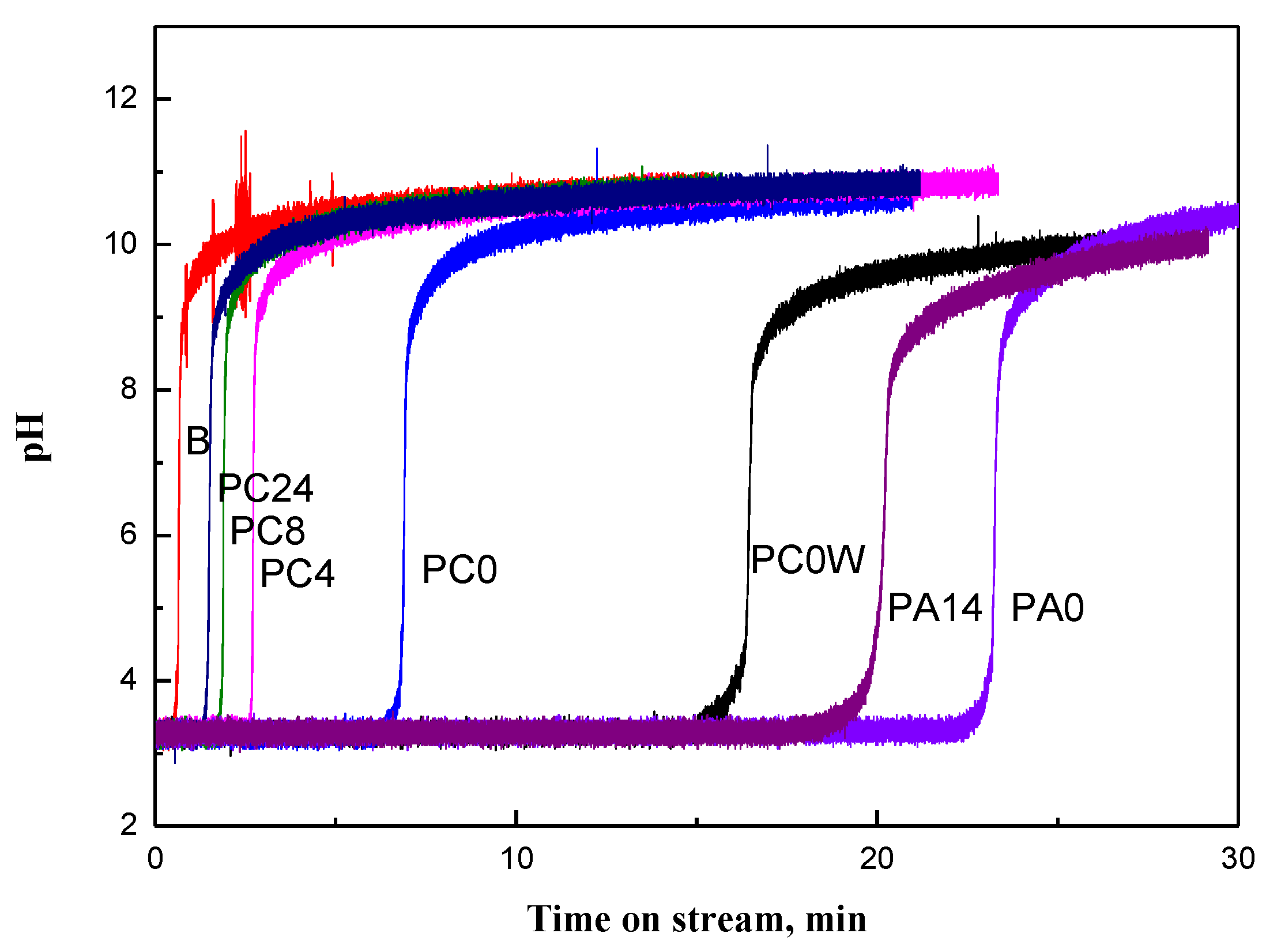
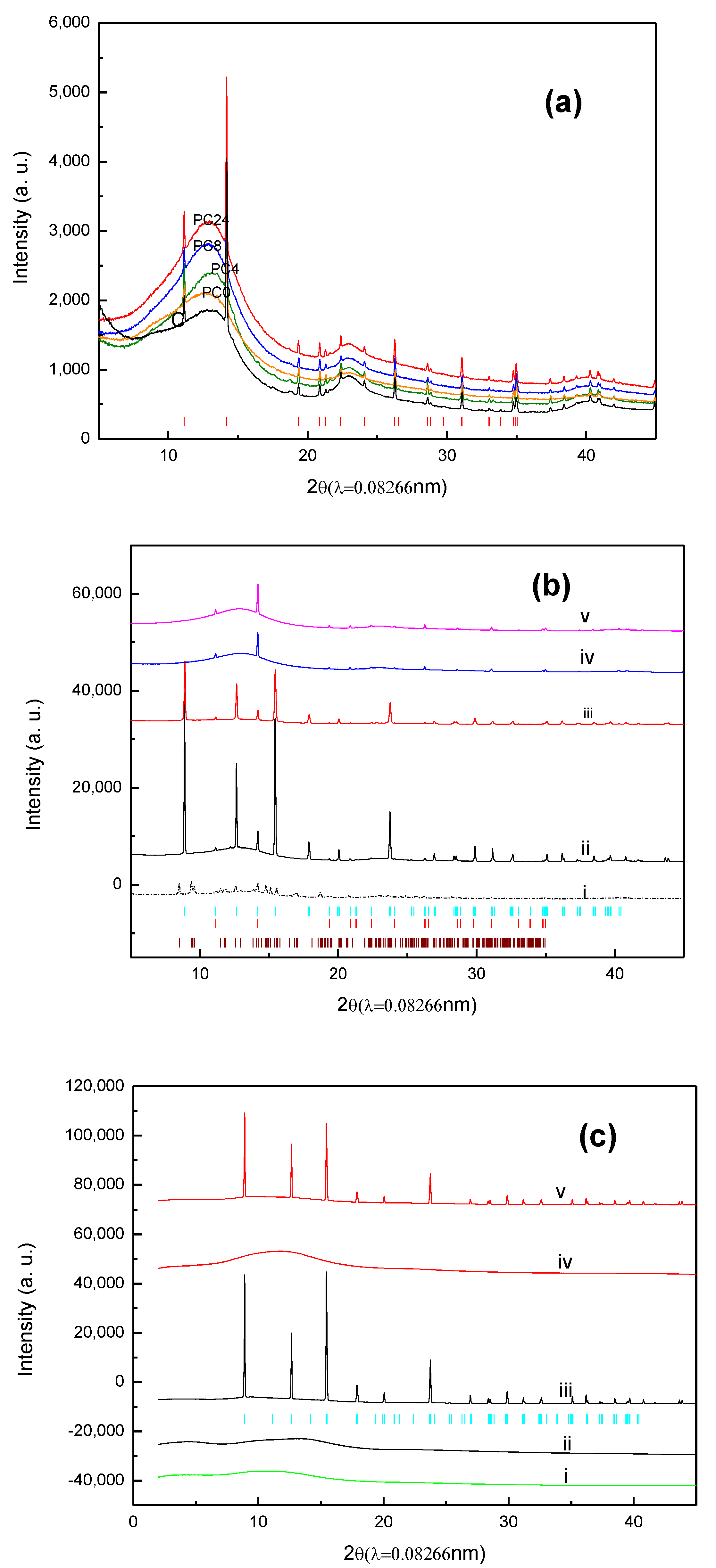

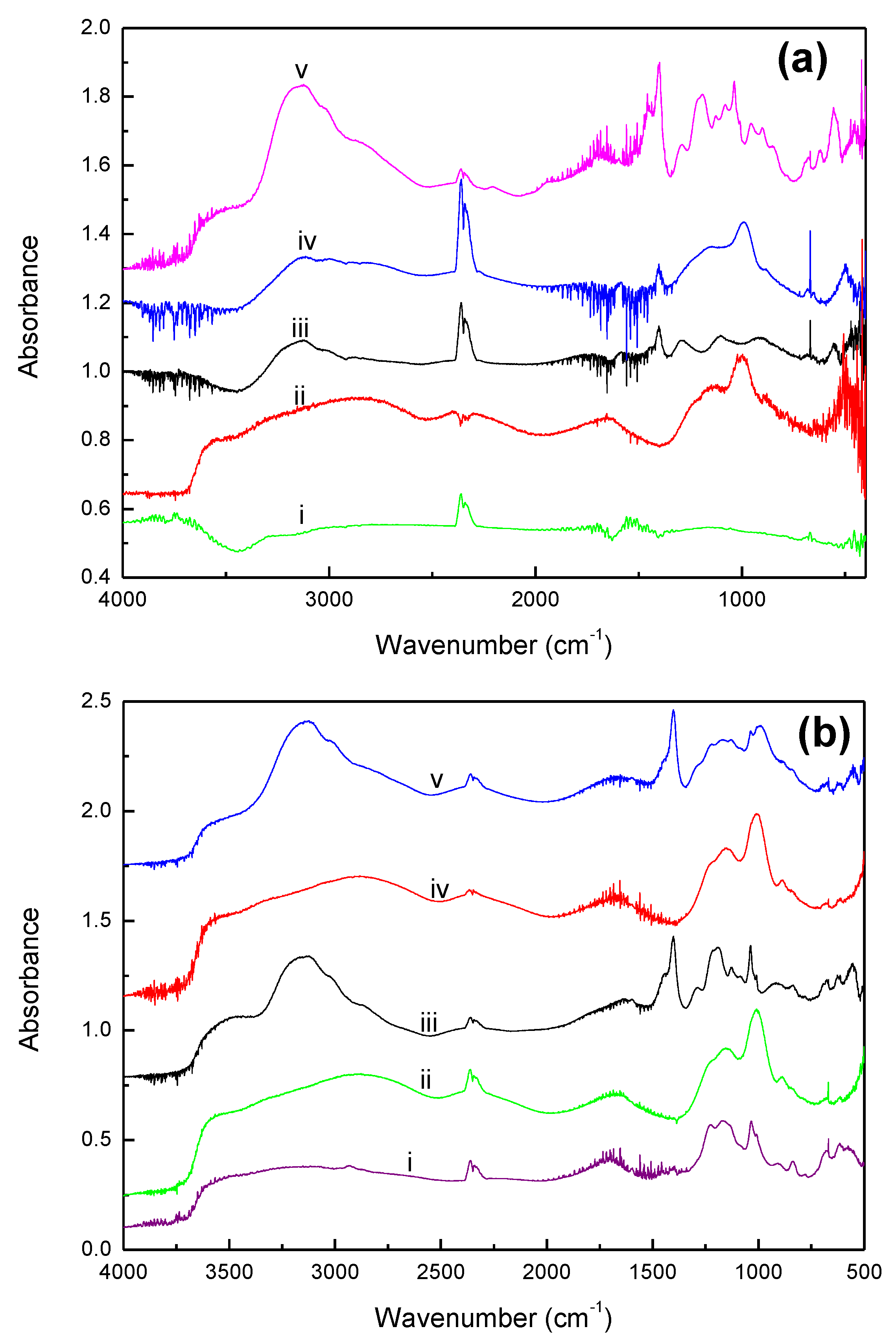
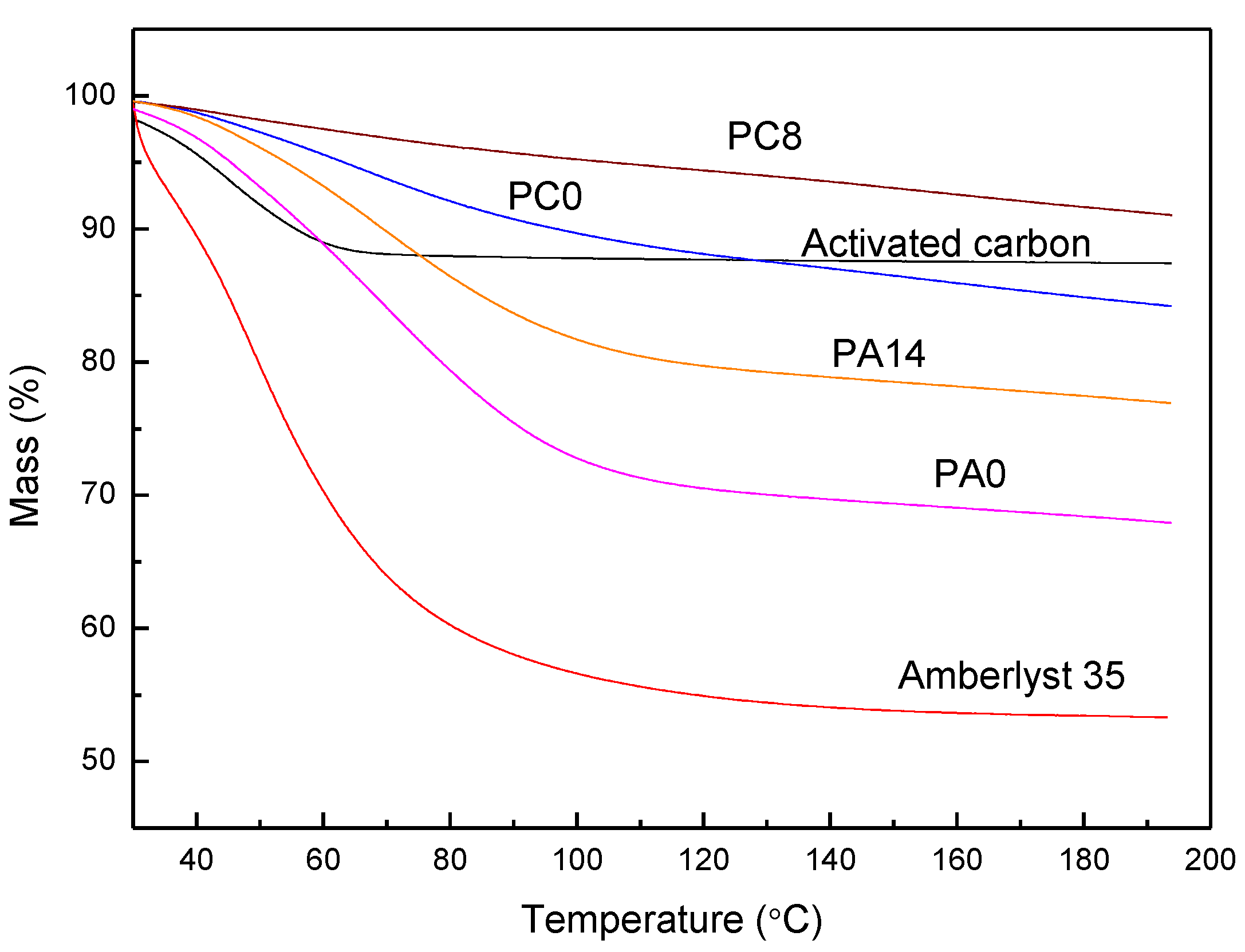

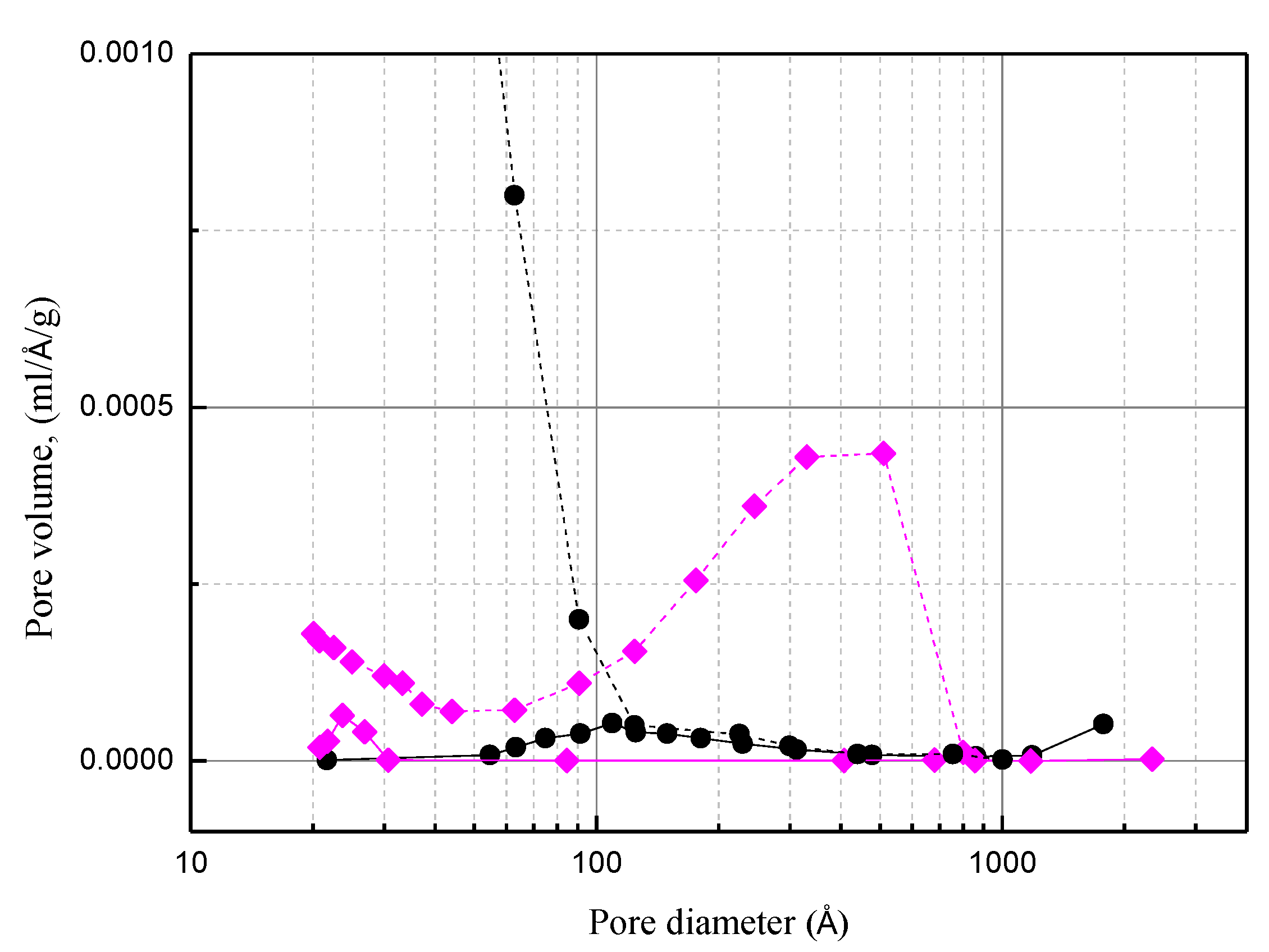
| Sample Name | PC24dry | PC0dry | PC0wet |
|---|---|---|---|
| Space group: SiO2 | P3221(trigonal) | P3221 (trigonal) | P3221 (trigonal) |
| H2(NH4)PO4 | - | - | |
| H(NH4)2PO4 | - | - | P21/C (monoclinic) |
| Lattice parameters: | |||
| H2(NH4)PO4(Å) | - | a = 7.477, c = 7.528 | - |
| H(NH4)2PO4(Å) | - | - | a = 10.959, b = 6.651, c = 7.967 |
| Lattice parameters: | a = 4.918 | a = 4.899 | a = 4.891 |
| SiO2(Å) | c = 5.409 | c = 5.392 | c = 5.380 |
| wRp | 0.0094 | 0.038 | 0.020 |
| Rp | 0.0058 | 0.025 | 0.014 |
| X2 | 0.082 | 0.106 | 0.136 |
| Grain size (nm) | |||
| SiO2 | 54 | 53 | 42 |
| H2(NH4)PO4 | - | 32 | - |
| H(NH4)2PO4 | - | - | 39 |
| Sorbent x | Water % Mass | P2O5 % Mass | g (Mole) NH3/ Kg Sorbent | Crystal(x)/ Crytstal(PC0) |
|---|---|---|---|---|
| PC0 | 16.0 | 26.3 | 28(1.64) | 1 |
| PC0 (wet) | 16.0 | 26.3 | 66(3.88) | 0.145 |
| PC4 | 9.0 | 30.9 | 11(0.64) | 0.284 |
| PA0 | 32.1 | 18.0 | 94(5.53) | 1.574 |
| PA14 | 23.4 | 23.9 | 78(4.56) | 1.198 |
Publisher’s Note: MDPI stays neutral with regard to jurisdictional claims in published maps and institutional affiliations. |
© 2022 by the authors. Licensee MDPI, Basel, Switzerland. This article is an open access article distributed under the terms and conditions of the Creative Commons Attribution (CC BY) license (https://creativecommons.org/licenses/by/4.0/).
Share and Cite
Hsieh, C.-C.; Tsai, J.-S.; Chang, J.-R. Effects of Moisture on NH3 Capture Using Activated Carbon and Acidic Porous Polymer Modified by Impregnation with H3PO4: Sorbent Material Characterized by Synchrotron XRPD and FT-IR. Materials 2022, 15, 784. https://doi.org/10.3390/ma15030784
Hsieh C-C, Tsai J-S, Chang J-R. Effects of Moisture on NH3 Capture Using Activated Carbon and Acidic Porous Polymer Modified by Impregnation with H3PO4: Sorbent Material Characterized by Synchrotron XRPD and FT-IR. Materials. 2022; 15(3):784. https://doi.org/10.3390/ma15030784
Chicago/Turabian StyleHsieh, Chu-Chin, Jyong-Sian Tsai, and Jen-Ray Chang. 2022. "Effects of Moisture on NH3 Capture Using Activated Carbon and Acidic Porous Polymer Modified by Impregnation with H3PO4: Sorbent Material Characterized by Synchrotron XRPD and FT-IR" Materials 15, no. 3: 784. https://doi.org/10.3390/ma15030784
APA StyleHsieh, C.-C., Tsai, J.-S., & Chang, J.-R. (2022). Effects of Moisture on NH3 Capture Using Activated Carbon and Acidic Porous Polymer Modified by Impregnation with H3PO4: Sorbent Material Characterized by Synchrotron XRPD and FT-IR. Materials, 15(3), 784. https://doi.org/10.3390/ma15030784






